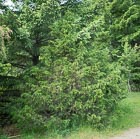
Typical open-grown tree, about 3-4 m tall and wide; Olympic Mountains, Washington [C.J. Earle, 2019.06.25].

Fallen tree, formerly about 7 m tall, on a nearly barren marine sandstone substrate, along with J. communis, Olympic Mountains, Washington [C.J. Earle, 2019.06.25].
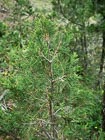
Terminal on a sapling, showing branch structure and young bark; Olympic Mountains, Washington [C.J. Earle, 2019.06.25].
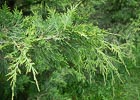
Branch with foliar units, showing typically drooping terminal shoots; Olympic Mountains, Washington [C.J. Earle, 2019.06.25].

Branch-lateral foliar unit showing leaf details; Olympic Mountains, Washington [C.J. Earle, 2019.06.25].

Nearly-mature seed cones; Olympic Mountains, Washington [C.J. Earle, 2019.06.25].
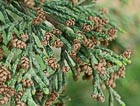
Old (previous year?) pollen cones; Olympic Mountains, Washington [C.J. Earle, 2019.06.25].
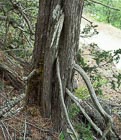
Bark on a tree about 15 cm diameter, Olympic Mountains, Washington [C.J. Earle, 2019.06.25].

Distribution map (Adams 2007). Note that this map omits the Olympic Mountains occurrences.
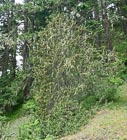
Largest tree found at Three O'Clock Ridge site; about 12 m tall and 35 cm dbh [C.J. Earle, 2019.06.25].
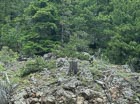
Typical occurrence at Three O'Clock Ridge; shrubby trees, some with erect leaders, on Crescent pillow basalt, in conjunction with drought-tolerant plants such as Pseudotsuga, Holodiscus, and Sedum [C.J. Earle, 2019.06.25].
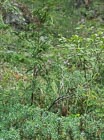
Sapling, emergent from a large mat of J. communis; Olympic Mountains, Washington [C.J. Earle, 2019.06.25].

Conservation Status

Juniperus maritima
R.P. Adams 2007
Common names
Seaside juniper (Adams 2007).
Taxonomic notes
Type, Canada, British Columbia, Brentwood Bay, 48.5799°N, 123.3369°W, elev. 5 m., 2006.05.29, R.P. Adams 11056.
This species was formerly included in Juniperus scopulorum and could be treated at an infraspecific rank, since the two species are nearly identical in appearance. However, both terpenoid and internal transcribed spacer (ITS) genetic sequence data clearly discriminate J. maritima from J. scopulorum and J. virginiana, two closely-related and very widespread species (Adams 2007, 2009). These three taxa join a group of seven rare Caribbean and Mexican species to form the smooth leaf margined junipers of the western hemisphere, a group of species that are so similar in appearance that a microscope and a detailed key are needed to tell them apart, unless you are an expert. The degree of genetic differentiation that sets J. maritima apart from J. scopulorum and J. virginiana is comparable to that which distinguishes other conifer species from each other, so it seems appropriate to recognize it as a good species.
Further work, using leaf terpenoid, nrDNA, and cpDNA has since found evidence that J. scopulorum populations in the Wallowa Mountains of Oregon and in the northern Rocky Mountains of British Columbia have been introgressed by J. maritima. The evidence of introgression does not extend to cpDNA, indicating that the introgression is likely due to airborne dispersal of J. maritima pollen, which is not necessarily proceeding under the current climate, but may be relictual from the species' Pleistocene distributions (Adams 2015).
Description
Extremely similar to J. scopulorum (q.v.), except that seed cones usually mature in 14-16 months (instead of 2 years), seeds are usually (instead of rarely) exserted from the ripe cone, and scale leaf tips are obtuse (rather than varying, acute to obtuse) (Adams 2007). Trees are a uniform dark green in color, with upswept branches; J. scopulorum in contrast shows much morphological variation, with a high percentage of very glaucous specimens (A. Jacobson email 2010.04.07).
Distribution and Ecology
U.S.A.: Washington and Canada: British Columbia. Occurring around Puget Sound from Whidbey Island north to Lesqueti Island and the adjacent coast of Vancouver Island, and in the northeast Olympic Mountains. The Puget Sound populations are primarily in rocky areas near the sea coast (with one known population on sand dunes). The Olympic Mountains populations are at elevations of 600 to 1700 m at Deer Park and Three O'Clock Ridge, in the relatively dry eastern Olympics; the Deer Park plants are krummholz in open tundra, while the Three O'Clock Ridge trees grow in forest with Pseudotsuga menziesii. All populations are physically disjunct and genetically distinct from J. scopulorum, which at its closest approach occurs at Ross Lake, BC, about 140 km to the east (Adams 2007, Adams et al. 2010). Historically, Rocky Mountain juniper has been reported from various other sites in the Olympic Mountains, and it seems likely that any such occurrences can be reassigned to J. maritima.
This species has not been recognized by the IUCN and thus has no formal conservation status. I can find no evidence that any other authority has assessed its vulnerability. Given its limited range and occurrence on many sites preferred for development, it appears to be at some risk.
"A striking aspect of the Puget Sound seaside junipers is their habitat. They all grow at the seaside (or lakeside) on granite or sand (Fig. 7). This is a very different kind of habitat than that found in J. scopulorum and J. virginiana. Juniperus scopulorum grows on dry, rocky mountainous soils. Juniperus virginiana is more cosmopolitan, growing in limestone areas as well as deep soils. Both J. scopulorum and J. virginiana are weedy junipers that invade old fields and disturbed roadsides. In contrast, the seaside juniper is not weedy and usually appears as if it is relictual (i.e., older trees, with few or no seedlings). The Puget Sound juniper's habitat seems to be very restricted and has only been collected in a few locations (Fig. 7). The Puget Sound climate is very different than the Rocky Mountain or the eastern US climates, having a mild, wet regime. In short, the Puget Sound juniper has evolved physiological genes to facilitate its growth in such an environment" (Adams 2007, p. 274).
Many junipers require or favor alkaline substrates, and alkaline soils are more common in maritime locations. Arthur Jacobson (email 2010.04.07) reports that J. maritima are doing poorly in the acidic soils at Washington Park Arboretum in Seattle, suggesting that J. maritima is another juniper that favors alkaline soils. However, the Olympic Mountains populations are on silicate substrates in areas that usually have acidic soils.
Remarkable Specimens
One 1972 record of a 23.8 m tall specimen at Deep Cove, British Columbia (A. Jacobson email 2010.04.07). Adams (2007) gives ring count data for seven trees. The oldest had 210 rings.
Ethnobotany
Gleaves (2018) presents a survey study in dendrochronology, testing for crossdatability and evaluating climate-growth response.
Observations
Adams (2007) provides information on several accessible populations. The best is described as a robust population of hundreds of trees that are protected in a park on Fidalgo Island, Washington; the reference is probably to Washington Park, which is just past the ferry terminal west of Anacortes. A leaning tree in a ravine there has been measured as approximately 18 m tall (R. Brightman email 2017.11.30).
A small population on coastal sand dunes occurs south of Deception Pass at Cranberry Lake on Whidbey Island, in Deception Pass State Park (Adams 2007).
The Juniper Beach residential neighborhood, at the eastern end of Camano Island just west of Stanwood, is named after a stand there, which is still present - both behind the beach, where the neighborhood (and the remains of a grove) is, and on higher ground to the north (scattered individuals). After Washington Park this is the best easily-accessed place to see this species represented by numbers of individuals of some size (R. Brightman email 2017.11.30).
Cypress Island, a few kilometers northwest of Anacortes, was named for its abundant J. maritima, and may have the largest stand(s) anywhere; access is only by water (it's a popular sea kayak destination).
The krummholz trees at Deer Park are within Olympic National Park, and are accessible from the end of the Deer Park Road.
The Three O'Clock Ridge trees are along road NF-2870, which winds south from near Dungeness Forks Campground, at about coordinates 47.91306,-123.11194. The location is an open-canopy forest, and trees have been collected both above and below the road, with the main stand just above the road. I visited this stand in 2019 (see the photos), and also found a smaller but similar stand at coordinates 47.88272, -123.13877. These occurrences are on thin soils in the relatively dry eastern Olympic mountains, and the trees occur on silicate substrates (pillow basalt and marine sandstone) along with other drought-tolerant plants typical of such sites, including Pseudotsuga menziesii, Juniperus communis, Holodiscus discolor, Arctostaphylos columbiana, Arctostaphylos uva-ursi, and Sedum oreganum.
In the city of Tulalip, near Interstate 5, several trees grow at Quilceda Creek, south of Marine Drive, near 2624 Marine Drive NE. Continue to parking at south end, overlooking meadow and creek. Best examples are easily spotted around edge of meadow (R. Brightman email 2017.11.30).
Remarks
Adams (Adams et al. 2010, Adams 2015) has speculated at length upon the likely Pleistocene and post-Pleistocene history of J. maritima and J. scopulorum, presenting multiple lines of evidence that J. maritima found a Pleistocene refugium on the Olympic Peninsula and that otherwise the distributions of both species shifted considerably during glaciations and interglaciations. See the cited sources (both are freely available at phytologia.org) for details.
Citations
Adams, R. P. 2007. Juniperus maritima, the seaside juniper, a new species from Puget Sound, North America. Phytologia 89(3):263-283.
Adams, R. P. 2009. THe leaf essential oil of Juniperus maritima R. P. Adams compared with J. horizontalis, J. scopulorum and J. virginiana oils. Phytologia 91(1):31-39.
Adams, R. P., G. Hunter, and T. A. Fairhall. 2010. Discovery and SNPs analyses of populations of Juniperus maritima in the Olympic Peninsula, a Pleistocene refugium? Phytologia 92(1):68–81.
Adams, R. P. 2015. Allopatric hybridization and introgression between Juniperus maritima R. P. Adams and J. scopulorum Sarg.: Evidence from nuclear and cpDNA and leaf terpenoids. Phytologia 97(1):55–66.
Gleaves, Dustin. 2018. Dendrochronology of seaside juniper (Juniperus maritima). M.A. Thesis, Western Washington University, Bellingham, WA.
See also












